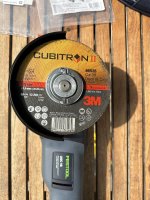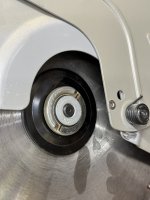festal said:
Richard/RMW said:
Cheese said:
That's a real nice jig you made Richard [thumbs up] I just may have to copy that. [big grin] Was the slotting done with the Shaper Origin? I really like the hold down feature, simple but effective, very clever.
Thanks. Yes, cut with Origin on the WorkStation with and o-flute. It's been greeting a regular diet of 6061 lately.
RMW
Still trying to figure out how its used lol
Not sure I can do this with words.
Say I am starting with a piece of bar stock that varies from 39 to 41mm over a 100mm length, and I need to finish at 38.1mm over the length. With the hard stop against the grinder front esdge I'd use a 38.1mm gage block pushed against the disk to set the fence. The hard stop prevents the jig for moving any closer to the disk but it can slide further away.
With the rough stock clamped against the fence there is between 0.9 and 1.9mm hanging over the front edge and the hard stop is not touching the front edge of the grinder. I just grind that stock away until the hard stop prevents any further movement towards the disk and the stock is now the same size as the dimension the fence was set to.
Make any sense? A 10 second video would make it clear.
RMW


